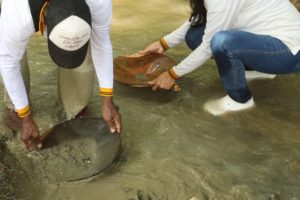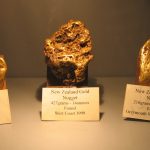My first introduction to gold mining in Colombia was through stories told years ago by a friend of the family. His father had been mining in the country sometime in the 1920s and hit it rich. He brought the gold back with him to the states by ship. But partway into his journey he began to suffer from yellow fever and probably malaria which left him delirious. His findings were stolen from him on the ship, leaving only a few nuggets in his possession. Two of those nuggets ended up as presents to my father from our friend. We still have those in our collection.
I have been in Santa Fe de Antioquia for a month. Earlier, I had driven by this landscape once before, on the way to Puente Colgante de Occidente (a historical bridge which date from the 1880s). I remember thinking to myself; this looks like gold bearing country. And sure enough, my two guides brought me back here; we exited our Tuk Tuk on the side of the road next to a small stream. My guides were a father/daughter team. The father learned gold mining from his father and in turn passed the knowledge on to his daughter Alba who runs, Ruta Turistica Barequeando Andando, a small tour company in Santa Fe de Antioquia. Whatsapp number: +57 304 365 6485
Our tools were a shovel, several wooden gold pans, a machete, a hollowed out bowl from a non edible tree fruit and knowledge. This was the first time I had ever used a wooden pan (normally I use metal or plastic pans). This particular pan conveniently came with a handle but was very shallow so one had to be extra careful when panning not to lose the gold over the side. We moved down the creek slowly, stopping to take samples every once in a while. We finally hit a rich area in the middle of the creek. This section based on the water flow was filled with burlap and other old plastic sacks. These had created a catch area for lots of sediment and as it turns out, also gold flakes. We spent most of our morning here panning, cutting the bags open with a machete and sliding the small pieces of gold into a hollowed out bowl.
We continued down the creek – walking in the gravel and sometimes sinking quite deep into the mud. Eventually we could not walk any further; the creek ended at Rio Cauca, a massive fast moving brown colored river. Locals cross with canoes, which they also use for fishing. But we would definitely not be attempting to cross this river today.
We sat down and began to separate the pieces of gold from the black sand concentrate. The old man used a traditional method which I have never seen before. He grabbed some leaves from a certain tree, crushed them up in his hands and dipped them into water contained in one of the gold pans. The water immediately turned green. Within moments the gold was in one part of the pan and the black sand in another. Voila!


















Excellent article.
I remember the nuggets of gold your dad showed me! Gold mining seems to run in your family!
Teh. Yep! Once one has gold fever it’s hard to give up prospecting :))